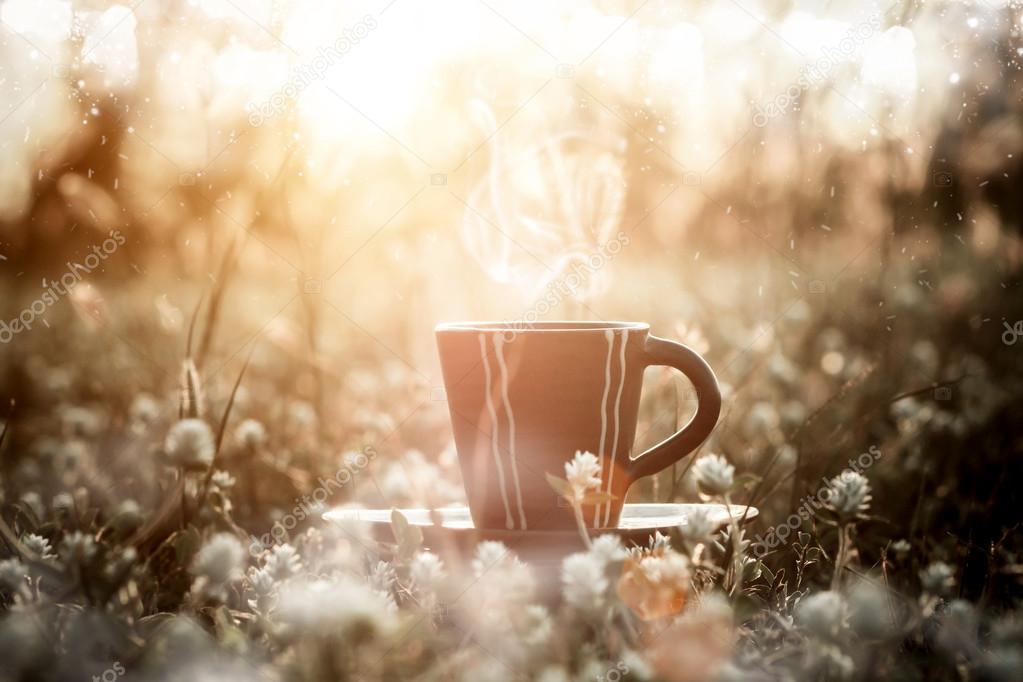
Traditional coffee in the garden early in the morning Traditional, Early morning, My coffee
The next time you finish your morning coffee, think twice before dumping the grounds. Coffee grounds can do wonders in your garden, not necessarily in the ways you would expect. Although they do not provide abundant nitrogen and do not lower soil pH much; they can enrich your garden soil and compost pile. Plus, they do not contain any harsh.

Prairie Charm Morning coffee in the garden / Ranná káva na záhrade
Add 2 cups of brewed coffee grounds to a 5-gallon bucket filled with water. Let the "tea" steep overnight then use this brew as a liquid plant fertilizer. Use it to feed worms. Above: Starbucks gives away bags of free coffee grounds to gardeners. Vermicomposters say that their worms are also coffee addicts.

Coffee in the garden💜 Хорошо, когда все хорошо и можно просто пожелать всем доброго утра 😊 Хочу
The amount of coffee grounds to use in your garden depends on various factors, such as the size of your garden, the type of plants you are growing, and the current soil condition. As a general guideline, you can start by applying a thin layer of coffee grounds around your plants or mixing them into the soil at a ratio of 10-20% coffee grounds.

Coffee cup on wooden table morning coffee in the garden vintage tone Stock Photo Alamy
Coffee grounds will make your plants grow faster! Adding grounds right around your plants is just like adding compost! Fresh grounds keep all sorts of pests away! The anecdotal wisdom seems to point to coffee grounds as a miracle garden amendment.

Morning coffee in the garden — Stock Photo © Noppharat_th 59687335
Your pile should contain no more than 20% grounds in the overall volume. Once decomposed, the coffee-rich compost is ready for use in your gardens and containers. 2. Use Coffee Grounds as Mulch. Cooled fresh coffee grounds can be used as a mulch too. Spread a layer 1/2 inch or thinner over the soil surface.

Morning coffee in the garden. — Stock Photo © Noppharat_th 59308259
5. Mulch. Mulch, which is generally used to retain moisture in the soil, can help to keep your garden looking neat and tidy - simply mix the coffee grounds with leaf mould to create the mulch.

Using Coffee Grounds in the Garden HGTV
Coffee that has been roasted but never brewed is fine for acid-loving plants, including rhododendrons, azaleas, hydrangeas, Pieris, andromeda and camellia. Uyterhoeven suggests sprinkling those.

Morning coffee in the garden ⬇ Stock Photo, Image by © Noppharat_th 34176663
If you are used to tossing the grounds from your morning coffee every day, you might want to reconsider. With coffee grounds, you have a fabulous source of organic matter right at your fingertips. The grounds can be added to the compost or used as a fertilizer.

Cup Of Coffee In The Garden Stock Photo Image of warm, arabica 120179834
Getty Images The safest way to use coffee grounds in the garden is to add them to compost containers or worm bins. Used grounds rot down well, and homemade compost is superb for improving soil and growing healthy plants.

Coffee cup in the garden stock photo. Image of brown 49039824
I start everyday with coffee in the garden…..sometimes by walking through it, which lets me see how everything is doing and think about future plantings. But most often I start my morning coffee ritual by sitting on this bench. I like this bench in particular because it has a view of our earliest.

Coffee in the garden stock image. Image of snack, morning 30284573
You can spread fresh coffee grounds in acid-loving vegetable beds. Root crops like radishes and carrots favor acidic soil, especially when planting. Fresh coffee grounds are said to suppress the growth of weeds in the garden. Only a few plants can withstand or require a high concentration of acid.

Coffee in the garden (With images) Outdoor projects, Garden images, Garden
Simply sprinkle the coffee grounds on the soil around the plants or gently mix them into the first 1-2 inches of soil. Adding coffee grounds directly to the soil early in the season will help jump-start young plants. You can also add the coffee grounds to your compost pile. Coffee grounds composting is a great way to improve the richness and.

Enjoying Coffee Time in the Garden Stock Image Image of hand, bouquet 147516403
1. Compost Them An easy way to use coffee grounds is to compost them! Putting coffee grounds in your garden helps improve the soil's water retention, aeration, and drainage. And they encourage microorganisms to thrive and will attract earthworms. So adding these to your compost is a great idea!

Morning Coffee in the Garden Stock Image Image of espresso, dish 186110317
By itself, the remains are too acidic — to put it to use effectively and safely, it should be mixed with another substance or diluted, according to HGTV. For example, you could mix your coffee grounds with compost. Despite researchers discovering that the leftovers have the potential to help tomato plants suppress diseases, these findings.

Drinking Coffee in the Garden Stock Image Image of relaxing, daylight 96066219
Tomatoes At the top of the list is this summer salad staple. Tomatoes are a staple in most gardens, but these popular veggies just don't get along with spent coffee grounds. The high acidity of the grounds can mess with their plant growth, and using coffee waste as a soil amendment can lead to stunted, unhappy tomato plants. 2. Blueberries

Morning Coffee in the Garden Stock Photo Image of cafe, outdoor 178975224
If you make a daily pot of coffee, you have a fabulous source of the organic matter right at your fingertips.. Mountain Gardener: 5 clever ways to use coffee grounds in your garden (Courtesy.